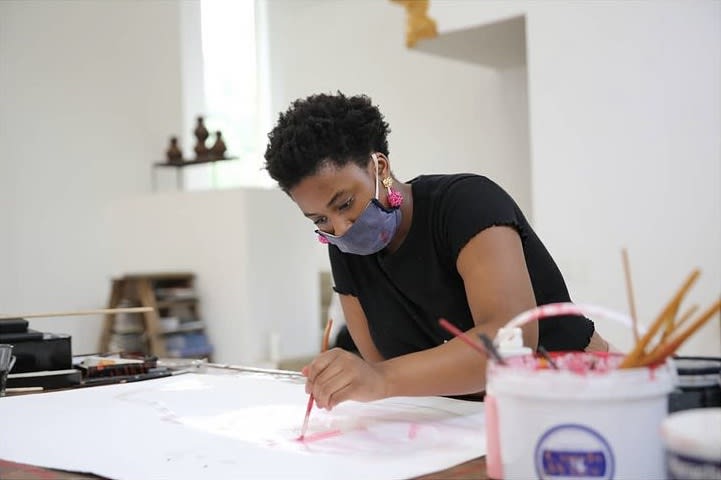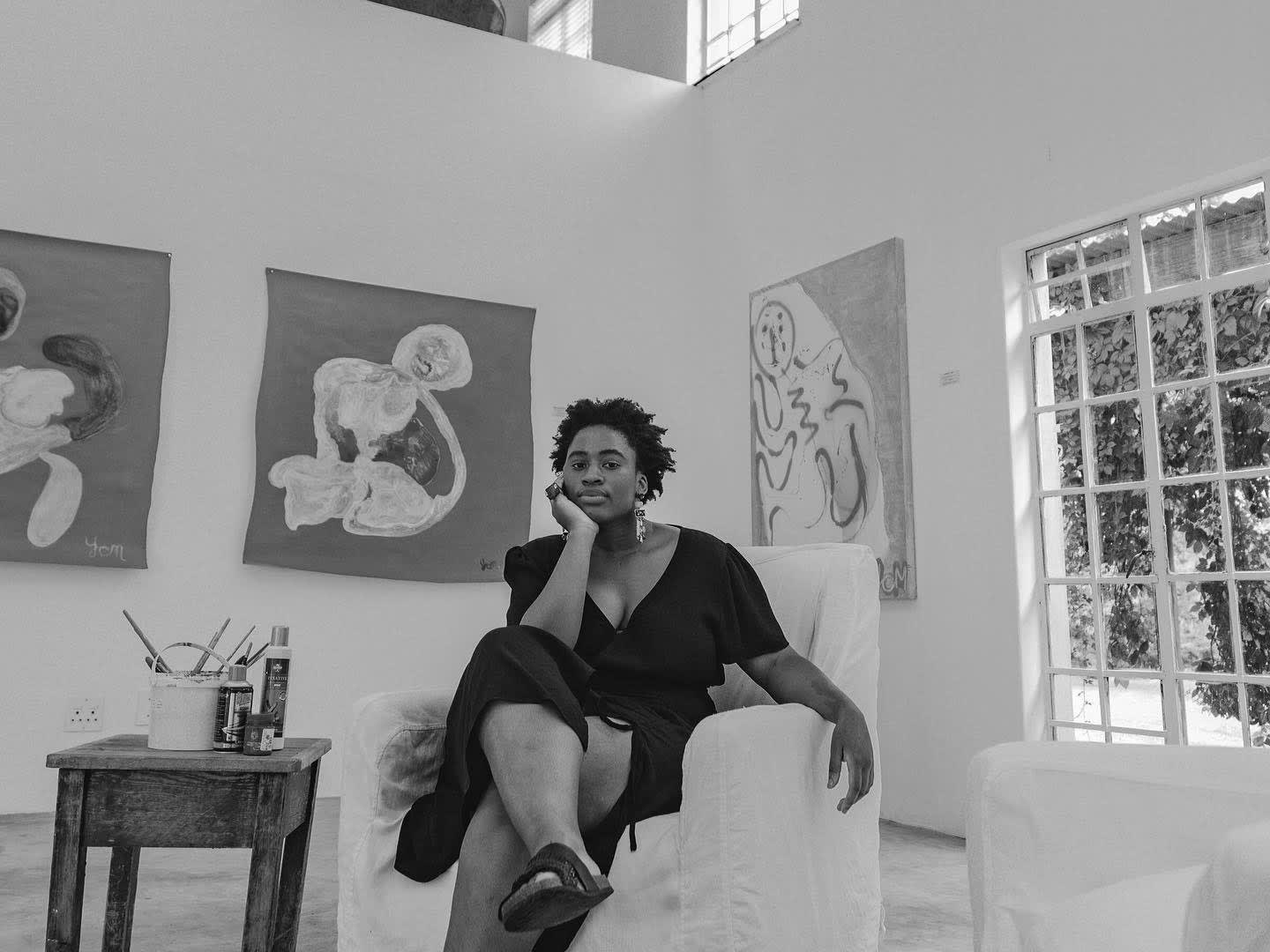
You stated "there is an emotional connection to my work" – Is it hard to part with your works by times?
There are artworks I miss from time to time that are no longer tangible. But it is beautiful to see collectors who send me images of them in their spaces .
You just completed an artist residency at NIROX Sculpture Foundation. How has this step effected your work?
In so many ways, the space alone, was an eye opener; it had to effect me personally, in order to project into my work.And what a big picture moment it was – it was amazing.
Given the residency’s location, did you embrace new media, or sculpture in particular?
Yes I tested new media. Most of my work I did there, is created in different mediums. It was a good mix. I definitely found myself excited to spontaneously challenge my imagination.
From October 2019 to 2020, you received the Bag Factory Young Woman Studio Bursary. How has your practice evolved during that time?
Being in company with the other artists allowed me to see all the different ways of being an artist; it made me feel like there are no limits to what you can do and try. You never know how the work will turn out it is unpredictable but also beautiful by the hands of the artist. Just going for it is how it evolved immensely.
What new topics came into your work, which materials? Were you influenced by Co-Awardees of the program?
I was still interested in learning with my second soloshow 'Symptoms of Nothing' - about women’s health and hypochondria, and how the two co-exist or do not , there are still so many unanswered questions from that theme. Someday I will revisit. The bag factory artists were so kind enough to offer me found objects and materials I could experiment with, sometimes it is best to take a shift and try something new; and it made room for a new technique on paper that I came up with.
Researching your work, one often comes across “mental illness, phobias, popular culture, relationships and storytelling” as topics inscribed in your work. What illnesses in specific, what phobias are you referring to?
I have alwaysbeen curious to know, whether it is a symptom of something or a phobia of something, what does it do and how, and when and why. I want to ask those questions to investigate and understand, and in the end to come to some sort of conclusion, which is not always there but it makes for interesting art.
You speak of your figures as “Characters”. Are there wider stories behind, do you mentally continue the figure-characters beyond the painting? Or is each painting just one situation, one state of mind, being portrayed?
With the after midnight series, it’s a combination of stories, thoughts, ideas; it’s not a whole of one; it is one situation, a state of mind like “after midnight -thinking“.
To me, your characters often seem children, and/or embryos. Could you confirm this; if so, what is the motive behind it; a certain vulnerability in all of us?
It is an amalgamation of anthropomorphic characters that started to take a surrealism expressionism approach. There is vulnerability in it because it becomes a matter of facing fears and understanding how much of an impact they have had on you and how you can overcome and challenge them to whatever you want. Especially as an artist.
In many cases, your characters are alone, only very rarely they do meet in one painting. Is loneliness another topic addressed by your work; and if so, again, is there a part of you in these feelings and pictures?
An aloneness in what you feel and how only you, can understand that and make sense of it.
You speak of "elements we are not sure about", the question of "Why am I this person?" as motives behind your work. Do you think or hope that your art can be a guidance in these regards, showing the recipient possible ways to go? Or is it rather an investigation, a diagnosis?
A guidance maybe, a search of some sort, or just a way to place all of my thoughts in a painting.
You have talked about social media’s role in recent African art. How far does this apply to your practice as an artist, what of social media’s impact is advantageous, which elements are rather disadvantageous to your work?
When I started out as an artist, all I had was social media. The opportunities I received and applied for were through social media, so it has given me the platform to showcase my work consistently, and for potential art collectors to see new works in progress and so on. If you want to show your work and grow a platform then it is a great start for sure but it is only a part or the other half of it. There are programs to apply for, galleries to check out, other artists to converse with, there is a collective role in that medium.

Yolanda Mazwana in the studio, Image: Matthew Dean Dowdle
Your artistic practice is essentially grounded in the South African art scene. Could you describe the working atmosphere? How far does your immediate environment influence or shape your work?
Rmb talent unlocked program, the bag factory to name a few. There are quite a lot of communities that support to grow artists, and it has certainly helped me to grow.
If Yesterday Was Tomorrow, What Is Today at Bode Projects was your first exhibition in Europe. What responses did you receive; and what are your expectations concerning future exhibitions on the European continent?
Exciting! was the response, and I would love to explore the art scene in Europe and do some residencies over there. All in due time.
Your material is varied, however, mostly classical. Paper, canvas, oil, acrylic, by times enamel gold. Given your autodidact way into the arts, could you tell us about your ‘material history’, what techniques and substances did you start with? Do you use specific material for specific matters?
I simply started with paper and a pen. Drawing portraiture and doing line-works, sometimes distorted, it was pretty cool. I do enjoy brown paper the most; and yes, I do use specific material for a specific matter but it doesn’t start of so rationalized.
Very striking about your paintings is their color. You use strong, bright colors, often ‘feminine’ in their connotation, as e.g. pink, violet, deep reds. Would you like to comment on that choice of coloring?
The choice of colour, is not always rationalized. It starts to find meaning. Eventually pink was such a dark subject matter in terms of how it was placed in the grotesque paintings I created. Red on the other hand is a bit lighter and softer, and more calming and that’s what I wanted to do. After midnight paintings speak of fear but aren’t supposed to look scary. Red is a strong colour but it represents soft.
Very characteristic about your work is a somewhat organic, ornamental – in its rolling, swaying sense – the line. What does this form, the line mean to you? As phenomenon in itself and as demarcator of other areas/ forms?
Organic, yes. There isn’t a limit in how I create, allowing a line to form how it is supposed to. It means letting go of control, control of your intent in what you want it to be and just letting go and going with it, my lines and forms are just that.

In one article about you one reads Gustav Klimt as one of your inspiration. Regarding your paintings, one could say, it is Klimt with all rigidity or precision taken out. Where do you see references, and where do you take your inspiration from Gustav Klimt from?
In my earlier works back in 2016-17, I worked a lot with gold when I started painting female figures. There was correlation there with Gustav Klimt in that aspect and I read about his work and eventually created in my own way.
In general, browsing through your work, I can’t help but notice traces of Modernity, also Cézanne, Dubuffet, Matisse, Munch. Are these artists important to you? And, if so, how did you come across their work?
I am an artist from the core of my being . There’s an important play in being self taught and finding inspiration in others artists, seeing similarities and connecting the dots of my own. Leaving room to learn but enough to stay authentic and pure to who I am as Yolanda Mazwana and the artist I am.
Further elements or references that come to my mind are shamanism, rituality, skulls, ghosts.
I see why you would think that, I’ve heard the comparisons and I see the connection there.
Your first solo exhibition was called ”Symptoms of Nothing”. What is meant by this? What symptoms are being referred to? And what if there is something behind the Symptoms?
My first ever solo exhibition was called "Secret home girls". My second solo was "Symptoms of Nothing" which spoke of women’s health and the state of the unknown in experiencing physical symptoms that can’t be pin pointed leaving them undiagnosed; essentially describing them as hypochondria or "nothing to worry about" as basically disregarded. Women tend to go through bodily changes and are misdiagnosed and left misunderstood, that can be incredibly difficult. Yes exactly: "what if there is something behind the symptoms?" that was my question exactly and what brought me to paint about it in the first place.

© Yolanda Mazwana Studio, Image: Botswele Bogotlane
You spoke about sketching and painting as a way of distracting you from the world, especially in Covid-times. Thinking metaphysically, where is your work to be located?
I created digital sketches to start with, and started imagining them in the surrealism expressionism aspect. Being in nature during my residency it took it to a metaphorical level.
In 2020, you created very delicate, personal drawings, very reduced in their nature. What made you take this different, subtle approach?
I think I was very vulnerable and it just happened, I didn’t think too much about it, I went to a different place and just zoned out and created. I remember where I was when I painted them and how it felt; I remember crying. I remember feeling a strong energy and all the work just poured out.
Do you feel more at home in big format and strong colors, compared to these works on paper?
Yes, I do I enjoy creating big format and strong colors more lately.
You described your work as “a million pages of a book”. What is on the next page?
Not sure yet; but I know it’s all connected.
Interview conducted by Christina-Marie Lümen